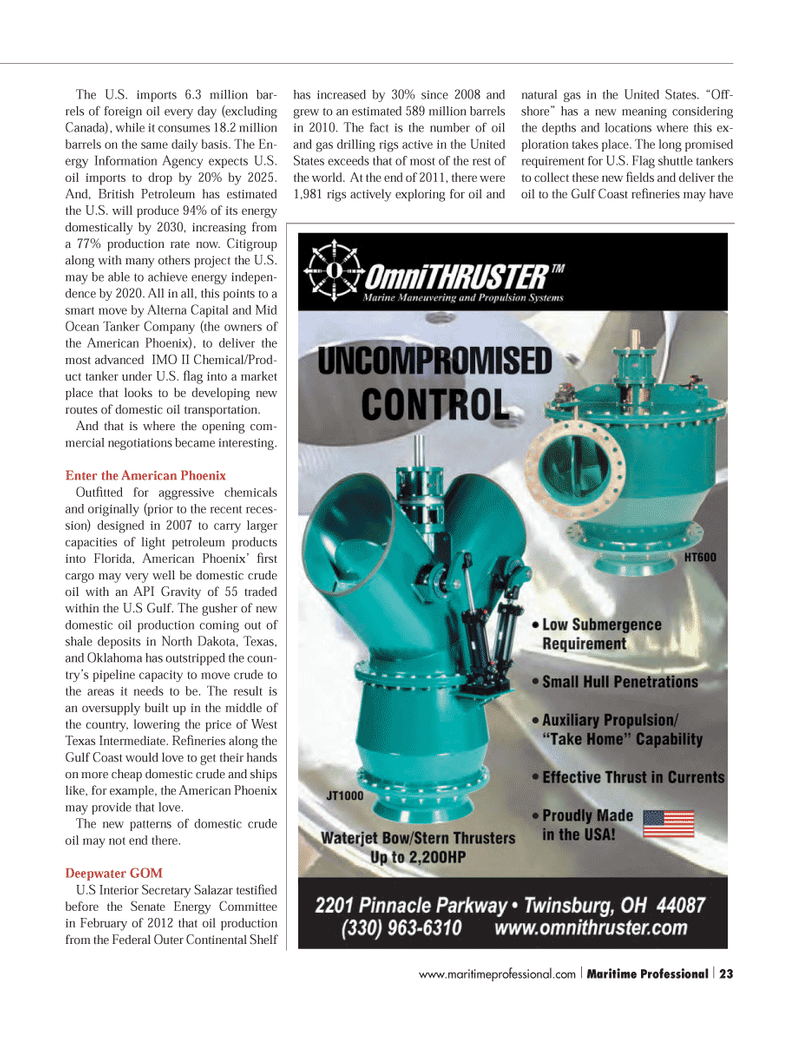
Page 23: of Maritime Logistics Professional Magazine (Q3 2012)
Classification Societies, Quality & Design
Read this page in Pdf, Flash or Html5 edition of Q3 2012 Maritime Logistics Professional Magazine
The U.S. imports 6.3 million bar- rels of foreign oil every day (excluding Canada), while it consumes 18.2 million barrels on the same daily basis. The En- ergy Information Agency expects U.S. oil imports to drop by 20% by 2025. And, British Petroleum has estimated the U.S. will produce 94% of its energy domestically by 2030, increasing from a 77% production rate now. Citigroup along with many others project the U.S. may be able to achieve energy indepen- dence by 2020. All in all, this points to a smart move by Alterna Capital and Mid Ocean Tanker Company (the owners of the American Phoenix), to deliver the most advanced IMO II Chemical/Prod- uct tanker under U.S. ß ag into a market place that looks to be developing new routes of domestic oil transportation. And that is where the opening com-mercial negotiations became interesting. Enter the American Phoenix OutÞ tted for aggressive chemicals and originally (prior to the recent reces-sion) designed in 2007 to carry larger capacities of light petroleum products into Florida, American PhoenixÕ Þ rst cargo may very well be domestic crude oil with an API Gravity of 55 traded within the U.S Gulf. The gusher of new domestic oil production coming out of shale deposits in North Dakota, Texas, and Oklahoma has outstripped the coun-tryÕs pipeline capacity to move crude to the areas it needs to be. The result is an oversupply built up in the middle of the country, lowering the price of West Texas Intermediate. ReÞ neries along the Gulf Coast would love to get their hands on more cheap domestic crude and ships like, for example, the American Phoenix may provide that love. The new patterns of domestic crude oil may not end there.Deepwater GOMU.S Interior Secretary Salazar testiÞ ed before the Senate Energy Committee in February of 2012 that oil production from the Federal Outer Continental Shelf has increased by 30% since 2008 and grew to an estimated 589 million barrels in 2010. The fact is the number of oil and gas drilling rigs active in the United States exceeds that of most of the rest of the world. At the end of 2011, there were 1,981 rigs actively exploring for oil and natural gas in the United States. ÒOff- shoreÓ has a new meaning considering the depths and locations where this ex- ploration takes place. The long promised requirement for U.S. Flag shuttle tankers to collect these new Þ elds and deliver the oil to the Gulf Coast reÞ neries may have www.maritimeprofessional.com | Maritime Professional | 23

 22
22

 24
24
